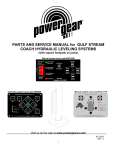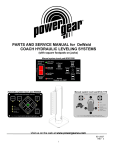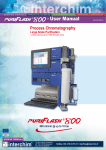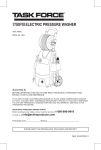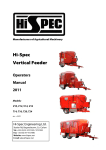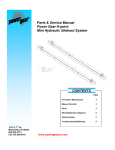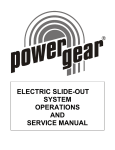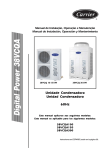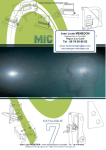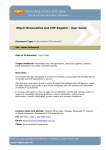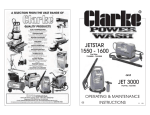Download PARTS AND SERVICE MANUAL for DEWALD HYDRAULIC SLIDE
Transcript
1 PARTS AND SERVICE MANUAL for DEWALD HYDRAULIC SLIDE OUT SYSTEMS Typical Dewald leveling and slide out pump assembly Typical Dewald slide out pump assembly Visit us on the web at www.powergearus.com 82-S0523 TABLE OF CONTENTS Page 3: WARNING Page 4: System description Page 6: Manual retraction procedure Page 7: Parts breakdowns Page 10: Pump assemblies Page 11: Parts list Page14: Cylinder Identification Page 16: Wiring diagrams Page 18: Hydraulic diagrams Page 20: Room seal and cable adjustment Page 24: Preventive maintenance Page 25: Instructions for installing seal kit 800176 Page 26: Diagnosing a cylinder for internal leakage Page 32: Troubleshooting Page 36: Warranty 2 3 WARNING • The hydraulic slide-out system is designed as a slide-out system only. Do not use the Dewald hydraulic slide-out system for any other reason or function. • The use of the power gear hydraulic slide-out system to perform any other function could result in damage to the coach and/or cause serious injury or even death. CAUTION - Check that potential parking locations are clear of obstructions before operation. CAUTION - Keep people clear of coach while operating the slide-out system. CAUTION - Never expose hands or other parts of the body near hydraulic leaks. High-pressure oil leaks may cut and penetrate the skin causing serious injury. CAUTION - Park the coach on a reasonably solid and level surface to optimize the slide-out system function. Read, study, and understand the Operations manual for Dewald slide out systems before operating the slideout system. SYSTEM DESCRIPTION Power Gear manufactures two different styles of the Dewald electro-hydraulic pump assemblies, the leveling and slide out assembly and the slide only pump assembly. There are different varieties of these styles that will be discussed in greater detail in the instructions for using the slide out. Leveling and slide out pump assembly: This pump assembly is found on motorized RV’s and can actuate four leveling jacks and up to 3 slide out rooms. It can also be used to actuate 4 slide rooms, only. Slide out pump assembly: This pump assembly is generaly found in towable campers but may also be used on motorized RVs. It can actuate up to 3 slide out rooms. Each slide room utilizes a cable and pulley system to synchronize the room as it travels in and out. Cables Pulleys Pictures are shown as reference only. Your system and its components may differ slightly from these pictures. 4 5 Slide out only pump assemblies The BL pump assembly can actuate up to 3 slide out rooms. Two hoses come from the ports in the top of the pump assembly and are attached to a hydraulic cylinder mounted underneath the slide room. On units with 2 or three rooms, the two hoses from the pump “T” off and then are attached to the cylinders. One switch is used to extend and retract all rooms. Most units have two switches for extending and retracting the room(s), one at the pump and one in the vehicle. BL 3 & 4 qt. assembly The selector manifold on the BL assembly allows for individual extension and retraction of the slide rooms. The manifold assembly on top of the pump has shut off valves for each room. When shut off, the valves stop the flow of hydraulic fluid to the slide out cylinder. Turning the shut off valves clockwise will prevent the room from being extended. Activation of pump assembly is from one switch. Most units have two switches for extending and retracting the room(s), one at the pump and one up in the vehicle. BL 3 & 4 qt w/ selector manifold The ESV pump assembly gives you individual, electrical control over the slide rooms. The system utilizes a mechanical valve controlled by a 12VDC coil for each slide out room actuated by the pump. Each room is extended and retracted by it’s own switch, located inside the coach. Pump assy. w/ ESV (Electric Solenoid Valve) Pictures are shown as reference only. Your system and its components may differ slightly from these pictures. 6 MANUAL RETRACTION PROCEDURE Note: Please read the entire manual before operating this system. VEHICLES WITH LEVELING + SLIDE ROOMS OR ESV PUMP ASSEMBLIES (Fig 6) Your Dewald Hydraulic Power System has been designed to operate both the leveling and/or slide out system from one power source. This power unit has a built-in hand pump for manually retracting the jacks and slide out room(s) if complete power should be lost to your leveling system. Hand Pump Operation 1. Turn each of the small slotted setscrews (A) on the front of the pump assembly clockwise until they stop. This will hold the valves open. Note: Vehicles that pre-date 2001 may have a red knurled knob on the end of each valve (A). Instead of turning a setscrew as instructed, you simply pull out the red knobs and turn them a ¼ turn in either direction. When you release them, they will stay locked in the "out" position. 2. Turn the silver (larger) knurled knob (B) on the front of the power unit 2 turns counter-clockwise. 3. Insert the pump handle into the receptacle (C) and pump the hand pump. 4. When all the jacks and/or the slide out room(s) are fully retracted, tightly close the silver knurled knob clockwise. 5. Turn each of the small slotted setscrews counter-clockwise, until snug. Note: If equipped with red knobs (A), turn them a ¼ turn to pop them back into normal operating position. Figure 6 Figure 7 VEHICLES WITH OR WITHOUT SELECTOR MANIFOLD PUMP ASSEMBLIES (Fig. 7) 1. 2. 3. Turn the silver knurled knob (B) on the front of the power unit 2 turns counter-clockwise. Insert the pump handle into the receptacle (C) and pump the hand pump. When room(s) are fully retracted, tightly close the silver knurled knob (B) clockwise. 7 PARTS BREAKDOWNS 2 1 22 7 16 5 42 19 4 23 6 3 17 28 27 20 BL 3 and 4 quart pump assembly (1, 2, or 3 rooms) See pg. 12 for part numbers and descriptions 21 7 3 25 or 26 16 5 6 1 22 24 2 42 19 4 23 3 28 17 27 BL 3 and 4 quart pump assy with selector manifold (2 or 3 rooms) 20 21 See pg. 12 for part numbers and descriptions 8 6 7 14 9 10 8 15 22 24 1 42 19 2 4 23 3 28 18 27 20 ESV (Electric Solenoid Valve) pump assy. (2 or 3 rooms) See pg. 12 for part numbers and descriptions 21 See pg. 12 for part numbers and descriptions 14 10 8 9 22 5 2 11 6 1 7 24 42 19 4 3 23 27 ESV Quad pump assy. (4 rooms) 20 21 28 9 6 See pg. 12 for part numbers and descriptions 13 12 14 10 7 22 8 9 2 5 11 1 24 42 19 4 3 23 27 21 Leveling + 1, 2, or 3 slide rooms. See pg. 12 for part numbers and descriptions 20 28 Typical Dewald slide out configuration. 29 Cable assembly (1 set of cables per room) 31 Cylinder Pulleys 37 10 PUMP ASSEMBLIES Slide out only pump assy’s (Round reservoir tanks) Round reservoir tanks come in 3 and 4 quart sizes. The length of the 3 qt is 8.35” long and 4 qt are 12” long. PU10141 PU10166 PU12038 PU12781 D4DA D4DA 3 qt D4DA 4 qt D4DA 4 qt w/ T's D4DA 3 qt w/ T's D4DA- Indicates that the assembly has no manual hand pump for emergency retraction of slide(s). LW LW- Indicates that the assembly is built with a lead wire (LW) only. There is no switch at the pump, only inside the coach. BL PU10813 3 qt LW, no switch PU12525 3 qt LW w/ fuse & diode PU13638 3 qt LW w/ fuse PU10437 PU10444 PU11525 PU11526 PU12527 PU12967 BL 3 qt BL 4 qt BL 3 qt w/ T's BL 4 qt w/ T's BL 3 qt w/ fuse & diode BL 3 qt w/ fuse BL- Indicates that the pump is wired for operation at both locations (BL). There is a switch at the pump and in the coach. PU11667 BL 3 qt w/ double selector PU12157 BL 4 qt w/ double selector PU12158 BL 4 qt w/ triple selector BL w/ double selector valves Has manual valves at the pump that can be opened or closed to control room operation. BL w/ triple selector valves Same as above ESV (Electric Selector Valve) PU13222 BL 4 qt w/ triple ESV & 70 amp relay pack PU13623 BL w/ double ESV & 70 amp relay pack PU13624 LW w/ double ESV & 70 amp relay pack ESV- Pump is built with 1 valve/coil assembly per room for individual, electrical control over each. Leveling and slide room pump assy’s (Square reservoir tanks) Square reservoir tanks come in 6 and 8 quart sizes. The length of the 6 qt tank is 12” and the 8 qt is 14” long. 6 quart pump assemblies PU12463 PU12464 PU12479 PU12598 PU13080 PU13081 PU13631 PU13635 500945 500956 PU13358 PU13632 PU13633 PU13634 PU13636 PU13637 500951 6 qt leveling only (3 valve) 6 qt leveling + 1 (4 valve) 6 qt leveling + 2 (5 valve) 6 qt quad-slide pump (4 valve) 6 qt leveling + 1 w/ diode on coil (4 valve) 6 qt leveling + 2 w/ diode (5 valve) 6 qt leveling + 1 w/ fuse (4 valve) 6 qt leveling + 2 w/ fuse (5 valve) DMI pumps with PG controls 6 qt leveling + 2 w/ fuse (5 valve) 6 qt leveling + 1 w/ fuse (4 valve) 8 quart pump assemblies 8 qt leveling + 2 w/ diode (5 valve) 8 qt leveling + 1 (4 valve) 8 qt leveling + 1 w/ diode on coil (4 valve) 8 qt leveling + 1 w/ fuse (4 valve) 8 qt leveling + 2 (5 valve) 8 qt leveling + 2 w/ fuse (5 valve) 8 qt leveling + 3 w/ fuse (6 valve) w/ diode = Assembly is built with diode harness on solenoids w/ diode on coil = Assembly is built with diodes inline on room coils w/ fuse = Assembly is built with fuse in line on red power lead for wall switches 11 #30 ** Measure hose from these two points to determine the hose length in inches. #29 ** Measure from these two points to determine cable length in inches. Also note the cable diameter (.25” or .188”). 32 33 35 34 36 30 38 37 16 39 31 See pg. 11 for part numbers and descriptions #28 Round reservoir tank 8.35” or 12” #28 Square reservoir tank 12” or 14” 12 PARTS LIST Item Qt y. 1 2 3 4 5 6 7 8 9 10 11 12 13 14 15 16 17 18 19 20 21 22 23 24 25 26 27 28 29 30 31 32 33 34 35 35 35 36 37 38 39 40 41 42 1 1 OK215 * 1 PT 2 WZ1 * * * * * 1 BA3 1D 1D * 1 * * * 2 2 2 2 VF109 2 VF103 2 1D 1D 1D 1D 1D 1 QA300 1 QA130 1 * * * * * * * * * * * * * * * 1 EC10 1D 1 1 80 Part Number DN11027 00S DN14866 10000 0000 IP10265 R IP10260 R DN13932 DN13933 Ste DN13937 12 0000 N12649 N12457 DN12494 DN13911 WO11380 IP10400 3 IP10450 6 VF12300 VF10210 VF10100 00 00 VA11000 N11305 N11306 N12560 N12620 N12567 00 00 ** ** See pgs.14 & 15 DN11397 DN13252 DN12148 DN13996 600172 DN13841 DN11879 DN10936 See pg. 12 IP10800 IP10750 IP10810 .75 IP10760 1 024 N11709 600072S 0176 Description 12VDC motor Pump/motor assembly (pump is not available separately) Hand pump cartridge valve assembly Breather cap 12VDC solenoid ocker switch, white ocker switch cover, white P.O. check valve m valve VDC coil Cube relay Suppression module Pressure switch Hose fitting 70 amp waterproof relay pack 90 deg. Hose fitting -pin pump switch -pin pump switch Screw, socket cap, 10-32 x ¼” Bolt, hex head, ¼ -20 x 1 3/4” Screw, BHC, 3/8”-16 x ½” Nut, ¼-20 hex Lock washer, split O-ring, black, #016 Faceplate, double selector manifold (2 rooms) Faceplate, triple selector manifold (3 rooms) Pump handle Reservoir tank, square, 12” (6 quart) Reservoir tank, square, 14” (8 quart) Reservoir tank, round, 8.75” (3 quart) Reservoir tank, round, 12” (4 quart) Synchronization cables (each room has 1 set of sync cables) Hydraulic hoses Cylinder Bracket, mounting, cylinder Adjustment, horizontal, end condition assy. Adjustment, vertical, bracket Adjustment, vertical, bracket 7.0” Adjustment, vertical, bracket 6.5” Adjustment, vertical, bracket 6.0” Wear pad, black 1.0” dia. Wear pad, white 1.5” dia. Pulley assembly .75” nylock nut 1.12” nylock nut ” jam nut .12” jam nut 24” ball screw electric Air cylinder Hand pump assembly O-ring seal kit (see page 23) * Quantities vary by system. ** Cable and hose assemblies should be ordered by the length of the cable or hose in inches. 13 #37 PULLY REPLACEMENT KITS Kit P/N PL10342 PL10343 PL10344 PL10345 PL10407 PL10413 PL10414 PL10521 BOM 600115 CW10100 SY60913 2 VF11500 VF12060 IP21004 CW10100 DN10661 SY60915 VF11500 VF12060 IP21004 DN10310 DN10280 DN10661 SY60914 4 VF11500 VF12060 IP21004 DN10310 DN10280 DN10661 SY60914 2 VF11500 VF12060 IP21005 IP21105 VF11500 VF12060 600116 CW10100 SY60913 4 SY60914 4 VF11500 VF12060 IP21005 CW10100 IP21105 SY60915 SY60916 VF11500 VF12060 600115 CW10100 SY60913 4 VF11500 VF12060 Qt. 2 2 4 4 2 2 2 2 4 4 2 4 4 2 8 8 2 2 2 2 4 4 6 6 4 4 6 4 8 8 6 4 6 2 2 8 4 2 2 4 4 Description 3" dia. double groove pulley assy pulley shaft .75 x 3.75 spacer pulley pvc pin cotter 1/8 x 1 washer flat 3/4 3" dia. double groove pulley pulley shaft .75 x 3.75 1-1/8" o.d. x 3/4" 3/4" x 1" sleeve pin cotter 1/8 x 1 washer flat 3/4 3" dia. double groove pulley pulley shaft .75 x 2.75 pulley mounting br 1-1/8" o.d. x 3/4" spacer pulley pvc pin cotter 1/8 x 1 washer flat 3/4 3" dia. double groove pulley pulley shaft .75 x 2.75 pulley mounting br 1-1/8" o.d. x 3/4" spacer pulley pvc pin cotter 1/8 x 1 washer flat 3/4 5.5" dia. single groove pulley bushing flange 1.1 pin cotter 1/8 x 1 washer flat 3/4 3" dia. single groove pulley assy pulley shaft .75 x 3.75 spacer pulley pvc spacer pulley pvc pin cotter 1/8 x 1 washer flat 3/4 5.5" dia. single groove pulley pulley shaft .75 x 3.75 bushing flange 1.1 3/4" x 1" sleeve 3/4" x 1-1/2" slee pin cotter 1/8 x 1 washer flat 3/4 3" dia. double groove pulley assy pulley shaft .75 x 3.75 spacer pulley pvc pin cotter 1/8 x 1 washer flat 3/4 Kit P/N PL10671 PL10672 PL10753 PL10791 PL11090 PL11102 PL12130 IP60080 BOM IP21004 DN10662 VF11500 VF12060 600115 CW10100 DN10317 VF11500 VF12060 600115 SY60900 VF11500 VF12060 IP21004 DN10661 DN10764 SY60915 VF11500 VF12060 600114 DN10310 DN10317 VF11500 VF12060 600114 CW10100 VF11500 VF12060 600114 CW10100 DN10310 SY60913 VF11500 VF12060 600114 DN10310 DN10317 VF11500 VF12060 Qt. 2 2 2 2 2 2 2 4 4 2 1 2 2 2 2 2 2 2 2 2 2 2 4 4 2 2 4 4 2 1 2 4 4 4 2 2 2 4 4 Description 3" dia. double groove pulley 1-1/8" o.d. x 3/4" pin cotter 1/8 x 1 washer flat 3/4 3" dia. double groove pulley assy pulley shaft .75 x 3.75 bracket pulley mtg pin cotter 1/8 x 1 washer flat 3/4 3" dia. double groove pulley assy pulley shaft .75" x 6" pin cotter 1/8 x 1 washer flat 3/4 3" dia. double groove pulley 1-1/8" o.d. x 3/4" 2" channel strap 3/4" x 1" sleeve pin cotter 1/8 x 1 washer flat 3/4 2.25" dia. double groove pulley assy pulley shaft .75 x 2.75 bracket pulley mtg pin cotter 1/8 x 1 washer flat 3/4 2.25" dia. double groove pulley assy pulley shaft .75 x 3.75 pin cotter 1/8 x washer flat 3/4 2.25" dia. double groove pulley assy pulley shaft .75 x 3.75 pulley shaft .75 x 2.75 spacer pulley pvc pin cotter 1/8 x 1 washer flat 3/4 2.25" dia. double groove pulley assy pulley shaft .75 x 2.75 bracket pulley mtg pin cotter 1/8 x 1 washer flat 3/4 14 #31 REPLACEMENT CYLINDER MEASUREMENT INSTRUCTIONS 15 #31 HYDRAULIC CYLINDERS LWW Current Production Cylinders are BOLD Physical Dimensions (inches) Part # Description 130-1226 1.5 X 42 non ext = OBSOLETE 130-1155 130-1156 130-1157 * 130-1159 CW10320 CW10323S CW10324S *CW10325S CW10326S *CW10327 CW10329 *CW10400 CW10416 *CW10420 *CW10500 *CW10520 CW10524S *CW10534 *CW10538 *CW10620 Color 1.5 x 24 ext 1.5 x 24 non ext 1.5 x 41 ext 1.5 x 38 ext 2 x 24 non ext 2 x 32 non ext 2 x 32 non ext 2 x 38 non ext 2 x 38 ext 2 x 40 non ext 2 x 48 non ext 2 x 40 (Dutchmen) 1.125 x 16.5 non ext 1.5 x 20 non ext 2 x 44 non ext 1.5 x 20 non ext 1.5 x 24 non ext 1.5 x 34 non ext 1.5 x 38 non ext 1.5 x 20 non ext Black Black Black Black Black Green Yellow Yellow Gray Gray Green Yellow Black Black AB 25.25 25.25 42.25 42.25 25.0 32.75 33.0 39.0 39.0 41.0 49.0 36.75 17.38 23.5 45.0 23.12 27.5 37.12 39.25 23.5 1.75 2.38 2.38 2.38 2.38 2.38 2.38 2.38 2.38 1.38 1.875 2.38 1.75 1.75 1.75 1.38 1.88 18.37 7.0 7.0 7.0 7.0 18.37 7.0 7.0 7 2.75 3.5 7.0 7.25 7.0 7.25 7.0 7.25 .75 .75 .75 .75 .75 .75 .75 .75 .75 .625 .75 .75 .75 .625 .75 .75 .625 41.25 1.75 7.0 .75 CW10638 1.5 x 38 non ext Purple 39.25 CW10719 1.5 x 19 ext Blue 20.25 CW10640 CW10720 *CW10724 CW10726 CW10729 CW10732 *CW10738 *CW10741 *CW10820 *CW10824 DN11816 *DN11997S CW11836 1.5 x 40 non ext 1.5 x 20 non ext 1.5 x 24 non ext 1.5 x 26 ext 1.5 x 29 non ext 1.5 x 32 ext 1.5 x 38 ext 1.5 x 41 ext 1.5 x 20 non ext 1.5 x 24 ext 1.5 x 40 (Dutchmen) 1.5 x 38 Green Gray Green Red Red Yellow Gray Blue Purple Green Black Black D 18.37 6.75 18.37 45.25 Blue Gray Gray Black C 1.75 1.75 1.75 20.88 25.25 27.25 30.25 33.25 39.25 42.25 20.88 25.25 40.5 41.5 1.75 1.75 1.75 1.75 1.75 1.75 1.75 1.75 1.75 1.75 1.75 1.75 1.75 1.75 7.0 6.75 18.62 7.12 7.0 18.62 4.0 18.62 18.62 18.62 3.5 18.62 3.18 7.0 .75 .75 .75 .75 .75 .75 .75 .75 .75 .75 .75 .75 .75 .75 .75 .75 .625 E .75 .75 .75 .75 .75 .75 .75 .75 .75 .75 .75 .75 .75 .625 .75 .75 .75 .625 .75 .75 .625 .75 .75 .75 .75 .75 .75 .75 .75 .75 .75 .75 .75 .625 LDH *CW10120 *CW10140 CW10175S *CW10200 CW10300S CW10410 2 x 32 2 x 17 2 x 24 2 x 32 2 x 38 2 x 44 33.0 18.0 25.0 33.0 39.0 45.0 Black Red Yellow Gray 2.38 2.38 2.38 2.38 2.38 2.38 7.0 7.0 7.0 7.0 7.0 7.0 1.12 1.12 1.12 1.12 1.12 1.12 n/a n/a n/a n/a n/a n/a SPECIALTY CYLINDERS #41- Air cylinder .5" #40 - 24” ball screw electric .5" 24.91" 26.53" .625" 16 WIRING DIGRAMS BL 3 and 4 quart, with or without selector manifold, with 1, 2 or 3 rooms Solenoids +12V from battery B A Wall Switch 12VDC motor M Pump Switch The green wire sends signal to the pump to retract rooms. The blue wire sends signal to extend. Double or triple ESV (2 or 3 rooms) 70 amp waterproof relay pack The green wire sends signal to the pump to retract rooms. The blue wire sends signal to extend. Pump switches Stem valve and 12V coil 5 amp fuse M 12VDC motor +12V from battery P.O. check valve Wall switches ESV manifold assy 17 Quad ESV (4 rooms) 5 amp fuse Cube Relay Wall switches B A Stem valve and 12V coil M +12V from battery 12VDC motor The green wire sends signal to the pump to retract rooms. The blue wire sends signal to extend. Quad manifold assy P.O. check valve Wiring diagrams for leveling plus 1, 2, or 3 rooms can be found in the Parts and Service Manual for Dewald Hydraulic Leveling Systems. 18 HYDRAULIC DIAGRAMS BL 3 or 4 quart – 1, 2, or 3 rooms (3 rooms shown) Pump assy. Pump assy. Retraction Extension BL 3 or 4 quart with double or triple selector manifold (triple shown) Selector manifold Extension Retraction 19 ESV (Electric Solenoid Valve) Triple ESV shown Extension Retraction ESV HYDRAULIC SCHEMATIC (triple ESV manifold shown) Retraction Extension P.O. check valve P.O. check valve is opened during extension by pressurized fluid from the extend side of the pump Retract hose port P.O. check valve is opened during retraction by pressurized fluid from the retract side of the pump Return to reservoir From pump Extend hose port Stem valve and 12vdc coil Stem valve is opened when 12V coil is energized with voltage. From pump Extend hose port PO check valve Return to reservoir Stem valve and 12V coil Retract hose port 20 ROOM CYLINDER ADJUSTMENT In/out seal adjustment- Cylinders that DO NOT HAVE STOP TUBES Room floor Nut pair “A” Jam nuts Nut “B” Nylon jam nut Cylinder IF ROOM SEAL ADJUSTMENTS ARE NECESSARY, start with nuts as far apart as possible, then tighten gradually until seals are made. Free travel Jamb nuts are used to adjust tightness of room seals. Nut pair “A” in the OUT direction; nut “B” in the IN direction. The “free travel” space accounts for the difference between the cylinder stroke and the room travel. In/out seal adjustment- Cylinders that DO HAVE STOP TUBES 1) Adjust the stop tube clockwise (towards the cylinder) until it stops. This will stop the room before the seals are compressed and prevent damage to flanges in the event of misadjustment. 2) Adjust the jam nuts in towards the stop tube. CYLINDER 5) Run the room in until the stop tube bottoms out. Adjust the stop tube out, then move the room in again repeating until the seals are compressed properly. Lock the stop tube in place with the jam nut. 3) Run the room out, then adjust the jam nuts to push the bracket until the seals are compressed properly. Tighten the jam nuts together to prevent movement. 4) Adjust the nylock nut in to the bracket. Slide System Timing Cable Adjustment The hydraulic slide out system does NOT use the cables to move the room, but rather to synchronize the room travel while the room is being moved. This synchronizing system keeps the room square as it slides in and out. If the wall of the slide for some reason is not parallel the outside wall of the R.V, you can adjust the cables as follows: 1. 2. Loosen cable nuts at side which is further IN (right side, as shown) Tighten cable nuts at side which is further OUT (left side, as shown 21 22 FLAT FLOOR ROOM HEIGHT ADJUSTMENT---FLUSH FLOOR STYLE SLIDES This TIP sheet is designed to provide information on setting the room height on a flat floor slide-out system utilizing angled rails. • • • With the room fully extended- Measure from the top of the moving slide-out rail to the bottom of the slide-out room floor up close to the coach. This is dimension “A”. Measure from the top of the moving slide-out rail to the bottom of the slide-out room floor out near the mounting bracket. This is dimension “B”. To calculate dimension “B” use the following formula: “B” (end bracket height setting)=“A” + (slideout room floor thickness) + ¼”. EXAMPLE: “B” (end bracket height setting) =“A” + (slideout room floor thickness) + ¼”. If “A” = 3-1/4” AND THE SLIDEOUT FLOOR IS 1” THICK Then “B”=3-1/4” + 1” + ¼” = 4-1/2” • Perform this check on each slide-out rail independent of the other. NOTE: 1) These figures are approximates. Each coach may be slightly different. 2) Refer to manufacturer of coach/trailer for correct slideout room floor thickness. 23 NON-FLUSH FLOOR TYPE ROOM ADJUSTMENT PREVENTIVE MAINTENANCE 24 1. 2. 3. 4. 5. 6. 7. Check the fluid level every month. Check and/or fill the reservoir with the room(s) in the fully retracted position. The fluid should be within 1/2 inch of the top of the reservoir tank. Change fluid every 24 months. Inspect and clean all hydraulic pump electrical connections every 12 months. Keep slide mechanism free of debris. If rooms are out for extended periods, it is recommended to spray exposed cylinder rods with a silicone lubricant every 5 to 7 days for protection. 8. If your vehicle is located in a salty environment (within 60 miles of coastal areas), it is recommended to spray the cylinder rods every 2 to 3 days with a silicone lubricant. Fill port breather cap RECOMMENDED HYDRAULIC FLUIDS FOR YOUR DEWALD HYDRAULIC PUMP The fluids listed here are acceptable to use in your pump assembly. Contact coach manufacturer or selling dealer for information about what specific fluid was installed in your system. It is not recommended that hydraulic fluid and automatic transmission fluids be mixed in the reservoir. In most applications, Type A automatic transmission fluid (ATF, Dexron III, etc.,) will work satisfactorily. Mercon V is also recommended as an alternative fluid for Dewald hydraulic systems. If operating in cold temperatures (less than -10° F) the jacks may extend and retract slowly. For cold weather operation, fluid specially formulated for low temperatures may be desirable. Mobil DTE 11M, Texaco Rando HDZ-15HVI, Kendall Hyden Glacial Blu, or any Mil. Spec. H5606 hydraulic fluids are recommended for cold weather operation. Please consult factory before using any other fluids than those specified here. 25 INSTRUCTIONS FOR INSTALLING SEAL KIT 800176 VA25400 O-rings, black #904 VA1100 O-rings, black #016 DN11027 12VDC motor VA20000 O-rings, white VA14350 O-ring, thick (install this in the groove) DN14866 Cartridge valve OK21500S pump/motor ass’y Put rounded side of washer towards hand pump 600072S hand pump assy DN10672 lift tube Torque to 70 in/lbs. VA25300 O-ring (install this o-ring around the edge) Seal kit 800176 contains the following parts: 1. 2. 3. 4. 5. 6. 7. 8. 9. 10. 11. 12. 13. 14. 15. 16. 17. 18. 19. 20. 21. Qty. Part # 2 VA110 00 2 VA143 50 2 VA200 00 1 VA253 00 VA25400 4 Return all rooms and leveling legs to the travel/storage position. Disconnect the battery for the coach and pump system. Drain the tank of oil with a siphon. Mark each hose, and wire for their respective positions. Remove each hose from the pump assy. and insert the ends into a bucket in case of leakage. Remove the power leads to the pump motor (green, blue, and black). Remove the pump from its mounting bracket. Take it to a clean, well-lighted workbench for disassembly. Remove the tank; drain any remaining fluid and clean inside of tank with a lint free cloth. Remove the hand pump from the assembly by removing the two nuts and lock-washers. Removal may be difficult with the inlet strainers in place. While pulling the hand pump off of the hollow tubes, pivot the hand pump down to clear the strainers after it clears the tubes. Insert a long Allen wrench small enough to fit through the holes in the hollow tubes to check them to make sure they are tight (right hand thread). Clean the components before re-assembly. Install 2 new o-rings (VA25400) onto each tube (4 total), lubricate them with Dexron III. Re-install the hand pump onto the pump assy. Install one white o-ring (VA20000) onto each of the two tubes. Push the assembly together as much as possible to align the housing and tubes so the o-rings will be seated correctly. Re-install the nuts onto the tubes and tighten to 70 inch/ pounds. Install new o-rings (VA14350 and VA25300, 1 each) onto hand pump assembly and re-install the tank. Re-install the pump components in reverse order of disassembly making sure to match the hose and wire markings. Re-fill the tank with Dexron III fluid until ½” from the top of the tank. Run the rooms and or leveling legs to full extension, wait 30 seconds and retract the rooms and leveling legs. Repeat this 4 times. This should completely purge air from the system. Check the fluid level in the tank with all rooms and jacks retracted. Fill to proper level if necessary. Test the system for proper operation, leaks, etc. Note: Some systems do not require The two (2) VA25400 o-rings. One(1)extra VA14350 o-ring is included in the kit . DIAGNOSING A DEWALD CYLINDER FOR INTERNAL LEAKAGE 26 The following test can be used when no gauge / gate valve tool is available. It should be noted that the gauge will be more accurate and give more definite test results than this method. The piston seal inside of a hydraulic cylinder can deteriorate over time due to normal wear, contaminated fluid, etc. If a cylinder is suspected to be leaking internally, then diagnose using the following procedure: Check only one cylinder at a time. 1: Completely RETRACT suspected cylinder. 2: Remove the EXTEND hose at the cylinder. See page 17–18 for hydraulic diagrams to determine EXTEND and RETRACT hoses. 3: Push the RETRACT or IN switch for at least 10 seconds and note how much fluid is coming from the fitting. A small amount to trickle is normal, steady flow is not. The pump will groan but hold the switch for as long as 10 seconds. If internal piston seal is good, little to no fluid should be coming out of fitting. 4: If, at this point, the seal has proven to be faulty, then repair or replace cylinder. If seal appears to be holding pressure, continue with the diagnosis. 5: Re-attach the removed EXTEND hose. 6: Completely EXTEND suspected cylinder. If a vehicle lift is not accessible, it may be necessary to park the coach over a service pit to get leveling cylinder completely extended without lifting coach. 7: Remove the RETRACT hose at the cylinder. 8: Push the EXTEND or OUT switch for at least 10 seconds and note how much fluid is coming from the fitting. A small amount to trickle is normal, steady flow is not. The pump will groan but hold the switch for as long as 10 seconds. If internal piston seal is good, flow should be greatly reduced or stopped by then. 9: Do this with each cylinder, to determine a faulty cylinder. Cap (extend) side of cylinder Rod (retract) side of cylinder Diagnosing drifting rooms with a gauge and gate valve Probable Cause Leaks somewhere in the system Stem valves are in manual override position Faulty stem valve Faulty P.O. check valve Valve coils miswired Cylinder(s) leaking Bad o-ring in pump assembly Corrective Action Check all hydraulic hoses for visible leaks. Check that all connections are tight. Diagnose and replace as necessary any faulty cylinder Turn slotted set screws at the end of the valves counterclockwise until they stop. If system has red knobs instead of set screws, turn knobs until they “snap” back into position. Swap the suspicious valve with one of the other good valves. If the problem follows the valve, check for bad o-rings on the tip of the valve. If o-rings are OK, change valve. Swap the suspicious check valve with a good check valve. If the problem follows the check valve, check for damaged o-rings. If the o-rings are OK, change check valve. Check wiring diagrams. Replace cylinder or have cylinder resealed Install o-ring replacement kit #800176. 3000 psi Gauge shown with quick disconnect for connecting to the fill/purge fittings on the pump. Gauges assembled as shown here will be the most versatile for all applications. 27 28 Do you have a hydraulic problem causing the room to drift? Take this first Step in diagnosing. A. Relieve pressure on the system by moving the cylinders to somewhere in the middle of their stroke. B. Couple the gauge to the fill /purge fitting on the pump on the same side as the outlined color side of the decal (retract side-decal on the hose may say bottom or rod side of the cylinder). C. Run the pump to retract the jacks with the control. The pump should run for 5-7 seconds after reaching 1400psi, and should achieve at least 2000psi. D. Watch the pressure for 15 minutes. If the pressure falls below 1750 psi the system has a leak. The leak could be internal (and thus not visible), or external. This gauge is installed onto the retract side of the pump’s manifold. This will show if any portion of the system has a problem. It will not show you where the problem is however. The benefit of checking like this is that the gauge can be installed without creating a mess, and it is very quick. This gauge is shown as it would be installed on a pump for checking a bad cylinder. Always install the gauge on the hoses hooked up to the outlined color side of the decal, not the solid color side. 29 How do I use the gauge and gate valve to find the exact location of the problem? 1) Relieve pressure on the system by moving the cylinder being checked to the middle of it’s stroke. 2) Assemble the gauge and gate valve as shown in the diagram. Install it so that the gauge is between the gate valve and the pump. 3) Shut off gauge’s gate valve. 4) Run pump to 2000 psi. or more. 5) Note how much pressure seeps off in 15 minutes. Pressure should not go lower than 1750 psi. If it goes lower than 1750psi, the pump shuttle valve is bad and pump should be replaced. Replacement pump part number is OK21500S. (does not include tank or manifold) Hydraulic pressure gauge Gauge’s gate valve To jack leg Dewald leveling jacks pump assembly Systems using a single hydraulic cylinder per slide room: If the pressure remains above 1750 for 15 minutes, go on to step 6 6) 7) 8) 9) 10) 11) Move the gauge so that the gauge is between the gate valve and the cylinder on the retract hose. Close the hand pump valve. Open the gate valve. Retract jack completely (more than 2000 psi). Shut off the gate valve. Watch for falling pressure for 15 minutes. If pressure falls more than 200lbs it indicates a bad piston seal or other external leak. NOTE: some seals leak slower than others. If the room takes several days before drifting, extend the time that you observe the cylinder retraction pressure. Test each cylinder to find the exact source of the problem. To cylinder 30 31 Systems using two hydraulic cylinders per slide room: If the pressure remains above 1750 for 15 minutes, go on to step 6 6) 7) 8) 9) 10) 11) 12) Relieve pressure on the system by m oving the cylinder(s) being checked to the middle of their stroke. Move the gauge so that it is between the cylinders on the retract hose. Close the hand pump valve. Open the gauge’s gate valve. Retract completely (more than 2000 psi). Shut off the gauge’s gate valve. Watch for falling pressure for 15 minutes. If pressure falls more than 200lbs it indicates a bad piston seal or other external leak. NOTE: The cylinder with the leak will be the one on the gauge side of the valve. NOTE: In order to prove that both cylinders are not leaking, the gauge will have to be moved to the other side of the gate valve and the test repeated. NOTE: Some seals leak slower than others. If the room takes several days before drifting, extend the time that you observe the cylinder retraction pressure. Test each cylinder to find the exact source of the problem. 32 TROUBLESHOOTING Note: Information regarding Dewald leveling parts, service, and troubleshooting can be found in the Parts and Service Manual for Dewald Hydraulic Leveling Systems. Before starting to troubleshoot the system, check all harness connectors for proper connection. Also look for any loose or hanging wires and replace, tighten or connect as necessary according to the wiring diagrams contained in this manual. All 1 2 3 4 Pump assembly key All pumps discussed in this manual BL 3 or 4 quart assy. BL 3 or 4 quart with selector manifold assy. Double or triple ESV assy. Quad ESV assy. Pump assy. Troubleshooting any Direct Current (DC) electrical system should be done with caution and by a trained technician. Anyone unfamiliar with electrical systems should not attempt the troubleshooting procedures listed in this guide. Failure to follow these guidelines could result in personal injury or even death. Room(s) will not extend, pump does not run Probable Cause Low or no voltage at pump assembly 5 amp fuse blown All Bad connection of motor ground wire at pump Motor or pump has failed Solenoid “A” faulty 1, 2, 4 No signal to pump assembly 3 No signal to relay pack from wall switch(es) No signal from relay pack to 12VDC motor 4 Pump assy. All 3, 4 No signal to solenoid “A” from cube relay Corrective Action Verify that the battery is fully charged and connected to the electrical system. Check 5 amp in-line fuse at pump assembly. Replace as necessary. Check grounding of black wire coming directly out of 12VDC motor at the pump assembly. Check for continuity between blue and black wires of 12VDC motor. If no continuity, replace motor. If continuity is found, then replace pump/motor assembly. With any room extend switch pushed, small post of solenoid “A” should show 12V+.If so, then two large posts of solenoid “A” should have continuity across them. If no continuity, replace solenoid. Check for 12V+ at the pump assembly on the copper buss bar that ties solenoids “A” and “B” together. If power is found, jumper the two large posts on solenoid “A” to see if pump will run. If pump runs then continue trouble shooting system to isolate problem. The blue wire from the wall switches to the relay pack should show voltage when any room extend switch is pressed. If no voltage is found, then replace wall switch(es) as necessary. With any wall switch pressed, the lug on the relay pack with the blue wire attached should show 12V+. If not, then replace relay pack. With any room extend switch pressed, terminal 87a of cube relay should show 12V+. If so, then terminal 30 should show 12V+. If no voltage at 30, then replace cube relay. Room(s) will not extend, pump does run Probable Cause Low fluid level The silver, knurled knob on the hand pump is open Faulty coil(s) Valve coils miswired Corrective Action Fill tank to proper level. See Preventive Maintenance and Recommended Fluids, pg 21. Knurled knob must be turned clockwise for normal operation. Check for continuity across the two yellow wires coming out of each of the coils. If no continuity, replace coil(s). Check wiring diagrams. 33 Room extends, but erratically Pump assy. Probable Cause Room is out of synchronization All Pump assy. Room seals or rails dry Lubricate room seals and rails with silicone spray. Internal leak in slide room cylinder See “diagnosing a Dewald cylinder for internal leakage” , pg 19. Pump does not shut off when extend switch is released Probable Cause Solenoid “A” faulty 1, 2, 4 Faulty switch Relay pack faulty 3 Faulty switch Pump assy. 2, 3, 4 Probable Cause Faulty selector knob Cylinders plumbed to manifold incorrectly Stem valves are in manual override position 3, 4 Coils and/or switches wired incorrectly Faulty stem valve Pump assy. Probable Cause Air trapped in system 1 Corrective Action Chose correct selector knob. Remove selector knob from manifold assembly and inspect the end for damage or contamination. Swap with a known good valve on manifold. If symptom swaps, then replace selector knob. If symptom does not swap, then continue troubleshooting to isolate defective component. Check plumbing of cylinders (See hydraulic diagrams, pg. 17) Turn slotted set screws at the end of the valves counterclockwise until they stop. If system has red knobs instead of set screws, turn knobs until they “snap” back into position (see pg 6). Check wiring of coils and switches according to the wiring diagrams contained in this manual. Swap suspected stem valve with a known good stem valve on manifold. If symptom swaps, replace stem valve. If stem valve has red knurled knob on the end (old style), then valve and coil must be replaced. Room “creeps” back in once extended A leak somewhere in system All Corrective Action Remove blue wire from large top post of solenoid “A”. Test across the two large posts of solenoid “A” for continuity while the extend switch is pressed. If continuity remains after switch is released, then replace solenoid. Remove blue wire from large top post of solenoid “A”. Check for voltage at small bottom post of solenoid “A” while the extend switch is pressed. If voltage remains after switch is released, then replace switch. Remove large blue wire from lug of relay pack. Test across that lug and the center lug (red wire) for continuity while the extend switch is pressed. If continuity remains after switch is released, then replace relay pack Remove large blue wire from lug of relay pack. Check for voltage at blue wire in relay pack coming from switches while the extend switch is pressed. If voltage remains after switch is released, then replace switch. Wrong room extends Wrong selector knob chosen 2 Corrective Action See “cable adjustment”, pg 20. Bad piston seal in cylinder(s) Bad o-ring seal between hand pump and pump assembly The silver, knurled knob on the hand pump is open Bad piston seal in cylinder(s) Stem valves are in manual override position 3, 4 Faulty stem valve Corrective Action Check all hoses, hose connections, pump assembly, etc for any visible fluid leak. Repair any found leaks as necessary. Verify that hose connection ports on cylinder are pointing as close to 12 o’clock as possible. Cycle room(s) to complete extension and retraction allowing system to rest 5 minutes in-between cycles. Do this 4 times. This should purge the air from the system. Test for internal cylinder seal leakage per instructions on pg 19. Install o-ring kit #800176 as per pg 22. Knurled knob must be turned clockwise for normal operation. On the BL 4 quart pump assembly where 2 or more rooms are teed together, a bad cylinder on one room can make another room creep back in. Be sure to check all cylinders for internal piston seal leakage on these systems. Turn slotted set screws at the end of the valves counterclockwise until they stop. If system has red knobs instead of set screws, turn knobs until they “snap” back into position (see pg 6). Swap suspected stem valve with a known good stem valve on manifold. If symptom swaps, replace stem valve. If stem valve has red knurled knob on the end (old style), then valve and coil must be replaced. 34 Pump assy. Room(s) will not retract, pump does not run Probable Cause Low or no voltage at pump assembly 5 amp fuse blown All Bad connection of motor ground wire at pump Motor or pump has failed Solenoid “B” faulty 1, 2, 4 No signal to pump assembly 3 No signal to relay pack from wall switch(es) No signal from relay pack to 12VDC motor 4 Pump assy. All 3, 4 No signal to solenoid “B” from cube relay Probable Cause Low fluid level System overfilled with fluid Faulty coil(s) Valve coils miswired Corrective Action Fill tank to proper level. See Preventive Maintenance and Recommended Fluids, pg 21. Drain tank to proper level. See Preventive Maintenance and Recommended Fluids, pg 21. Check for continuity across the two yellow wires coming out of each of the coils. If no continuity, replace coil(s). Check wiring diagrams. Room retracts, but erratically Probable Cause Room is out of synchronization Pump assy. Check grounding of black wire coming directly out of 12VDC motor at the pump assembly. Check for continuity between blue and black wires of 12VDC motor. If no continuity, replace motor. If continuity is found, then replace pump/motor assembly. With any room retract switch pushed, small post of solenoid “B” should show 12V+.If so, then two large posts of solenoid “B” should have continuity across them. If no continuity, replace solenoid. Check for 12V+ at the pump assembly on the copper buss bar that ties solenoids “A” and “B” together. If power is found, jumper the two large posts on solenoid “B” to see if pump will run. If pump runs then continue trouble shooting system to isolate problem. The green wire from the wall switches to the relay pack should show voltage when any room retract switch is pressed. If no voltage is found, then replace wall switch(es) as necessary. With any wall switch pressed, the lug on the relay pack with the green wire attached should show 12V+. If not, then replace relay pack. With any room retract switch pressed, terminal 87a of cube relay should show 12V+. If so, then terminal 30 should show 12V+. If no voltage at 30, then replace cube relay. Room(s) will not retract, pump does run Pump assy. All Corrective Action Verify that the battery is fully charged and connected to the electrical system. Check 5 amp in-line fuse at pump assembly. Replace as necessary. Corrective Action See “cable adjustment”, pg 20. Room seals or rails dry Lubricate room seals and rails with silicone spray. Internal leak in slide room cylinder Check cylinder for internal piston seal leakage. See “diagnosing a Dewald cylinder for internal leakage” , pg 19. Pump does not shut off when retract switch is released Probable Cause Solenoid “B” faulty 1, 2, 4 Faulty switch Relay pack faulty 3 Faulty switch Corrective Action Remove green wire from large top post of solenoid “B”. Test across the two large posts of solenoid “B” for continuity while the retract switch is pressed. If continuity remains after switch is released, then replace solenoid. Remove green wire from large top post of solenoid “B”. Check for voltage at small bottom post of solenoid “B” while the retract switch is pressed. If voltage remains after switch is released, then replace switch. Remove large green wire from lug of relay pack. Test across that lug and the center lug (red wire) for continuity while the retract switch is pressed. If continuity remains after switch is released, then replace relay pack. Remove large green wire from lug of relay pack. Check for voltage at green wire in relay pack coming from switches while the retract switch is pressed. If voltage remains after switch is released, then replace switch. 35 Pump assy. Wrong room retracts Probable Cause Wrong selector knob chosen 2 2, 3, 4 Faulty selector knob Cylinders plumbed to manifold incorrectly Stem valves are in manual override position 3, 4 Coils and/or switches wired incorrectly Faulty stem valve Pump assy. Probable Cause Air trapped in system 1 Remove selector knob from manifold assembly and inspect the end for damage or contamination. Swap with a known good valve on manifold. If symptom swaps, then replace selector knob. If symptom does not swap, then continue troubleshooting to isolate defective component. Check plumbing of cylinders (See hydraulic diagrams, pg. 17) Turn slotted set screws at the end of the valves counterclockwise until they stop. If system has red knobs instead of set screws, turn knobs until they “snap” back into position (see pg 6). Check wiring of coils and switches according to the wiring diagrams contained in this manual. Swap suspected stem valve with a known good stem valve on manifold. If symptom swaps, replace stem valve. If stem valve has red knurled knob on the end (old style), then valve and coil must be replaced. Room “creeps” back out once retracted A leak somewhere in system All Corrective Action Chose correct selector knob. Bad piston seal in cylinder(s) Bad o-ring seal between hand pump and pump assembly The silver, knurled knob on the hand pump is open Bad piston seal in cylinder(s) Stem valves are in manual override position 3, 4 Faulty stem valve Corrective Action Check all hoses, hose connections, pump assembly, etc for any visible fluid leak. Repair any found leaks as necessary. Verify that hose connection ports on cylinder are pointing as close to 12 o’clock as possible. Cycle room(s) to complete extension and retraction allowing system to rest 5 minutes in-between cycles. Do this 4 times. This should purge the air from the system. Test for internal cylinder seal leakage per instructions on pg 19. Install o-ring kit #800176 as per pg 22. Knurled knob must be turned clockwise for normal operation. On the BL 4 quart pump assembly where 2 or more rooms are teed together, a bad cylinder on one room can make another room creep back out. Be sure to check all cylinders for internal piston seal leakage on these systems. Turn slotted set screws at the end of the valves counterclockwise until they stop. If system has red knobs instead of set screws, turn knobs until they “snap” back into position (see pg 6). Swap suspected stem valve with a known good stem valve on manifold. If symptom swaps, replace stem valve. If stem valve has red knurled knob on the end (old style), then valve and coil must be replaced. Locations of breakers, fuses, fuse panels, etc. are coach specific. Consult your coach owner’s manual or the coach manufacture for locations of these components. Power Gear Technical Service: 800-334-4712 www.powergearus.com LIMITED WARRANTY 36 Power Gear warrants to the origin al retail purc haser that the product will be free from defects in material and workmanship for a period of ( 2) years following the retail sales. Labor to repair these component s will be co vered for two years. Power Gear will, at its option, repair or replace any part covered by this limited warranty which, following examination by Power Gear or its authorized distributors or dealers, is found to be defective under normal use and servic e. No claims under this warranty will be valid unless Power Gear or its authorized distributor or dealer is notified in writing of s uch claim prior to t he expiration of the warranty period. Warranty is transferable pending documentation of original sale date of product. THIS WARRANTY SHALL NOT APPLY TO: • Failure due to normal wear and tear, accident, misuse, abuse, or negligence. • Products which are modified or altered in a manner not authorized by Power Gear in writing. • Failure due to misapplication of product. • Telephone or other communication expenses. • Living or travel expenses. • Overtime labor. • Failures created by improper installation of the product’s slideout system or slideout room to include final adjustments mad e at the plant for p roper room extension/retraction; sealing interface between slideout rooms and side walls; synchronization of inner rails; or improper wiring or ground problems. • Failures created by improper inst allation of leveling systems, incl uding final adjustments made at the plant, or low fluid level, wiring or ground problems. • Replacement of normal maintenance items. There is no other express warranty other than the foregoing warranty. THERE ARE NO IMPLIED WARRANTIES OF M ERCHANTIBILITY OR FITN ESS FOR A PARTICULAR PURPOSE. IN NO EVENT SHALL PO WER GEAR BE LI ABLE FO R ANY I NCIDENTAL OR CONSEQUENTIAL DAMAGES. This warranty gives you specific legal rights, and you may also have other rights, which vary from state to state. Some states do not allow the limitations of implied warranties, or the exclusion of incidental or c onsequential damages, so the above lim itations and exc lusions may no t apply to you. For service contact your nearest Power Gear author ized warranty service fac ility or call 1-800-3344712. Warranty service can be performed only by a Power Gear authorized service facility. This warranty will n ot apply to service at any other facility. At the ti me of requesting warranty service, evidence of original purchase date must be presented. Power Gear 1217 E. 7th Street Mishawaka, IN 46544 800/334-4712 www.powergearus.com






































